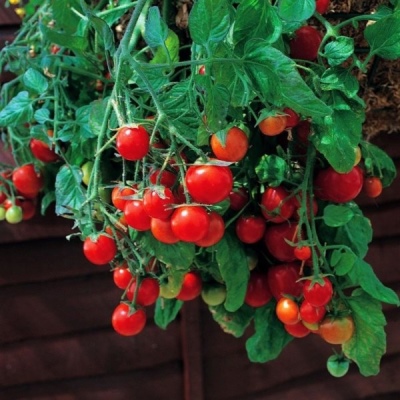
- Authors: Gavrish S.F., Morev V.V., Amcheslavskaya E.V., Volok O.A. (LLC "Gavrish Breeding Firm")
- Year of approval: 2001
- Category: grade
- Growth type: determinant
- Appointment: fresh consumption, for pickling and preserving
- Ripening period: early
- Ripening time, days: 94-97
- Growing conditions: for open ground, for a balcony, for growing on a windowsill, pot culture, decorative gardening
- Bush size: dwarf
- Bush height, cm: 20-30
Initially, a variety called Bonsai was bred for indoor cultivation. This variety is ideal for organizing a small vegetable garden on a windowsill, balcony or loggia. Today, the pot culture is also found in open areas.
Description of the variety
In addition to growing at home and in the open field, vegetable crops are used for decorative gardening. The fruits are eaten naturally or used for canning. Dwarf bushes can grow up to 20-30 centimeters, which makes them suitable for growing in pots and small containers. The color of the leaves is dark green. The size is medium. The structure is wrinkled. Standard.
The shoots are strong and do not need support. The green mass is dense. Inflorescences are laid above the sixth leaf.
The main qualities of the fruit
Unripe light green tomatoes gradually turn bright red. The sizes are small and weigh 24-27 grams. The shape is round. 5-6 tomatoes can grow on one brush at the same time. The percentage of dry matter is 8-10. The skin is even and smooth. Intermediate inflorescences. The number of seeds is small. The pulp is moderately dense and juicy.
Taste characteristics
The gastronomic quality of the crop is highly dependent on the cultivation conditions. It gains sweetness and aroma from the sun's rays, so tomatoes in the southern regions will taste better than fruits from the northern regions of the country.
Ripening and fruiting
Vegetables ripen early, the ripening period is only 94-97 days. Harvested from late June to late summer.
Yield
Despite the small size of the bush, up to one kilogram of fruit can be obtained from one plant.
The timing of planting seedlings and planting in the ground
Sowing seeds for seedlings is performed from early to mid-April. As for planting seedlings in the ground, work is carried out at the beginning of May, the age of seedlings is 30-35 days. It is advisable to pre-germinate the seed in a damp tissue for 5 days. During this time, sprouts should appear. After using light turf soil.
Care for the seedlings as follows:
until the emergence of seedlings, the container with seeds is kept warm and covered;
dive seedlings after the appearance of the first true leaf;
seedlings need 10-hour daylight hours, with a lack of sunlight, lamps will be needed:
hardening is performed before planting for a week, the temperature regime is 14 degrees Celsius.
If the variety will be grown outdoors, then in early March, the seedlings should be planted in separate cups or pots. After about 2 months, it can be transplanted to a permanent cultivation site.

Growing tomato seedlings is an extremely important process, because it largely depends on whether the gardener will be able to harvest at all. All aspects must be taken into account, from seedbed preparation to planting in the ground.
Landing scheme
The maximum permissible planting density is 3 bushes per square meter (for open areas).

Growing and care
The worst predecessors for this variety are pepper, eggplant or potatoes. Bushes feel comfortable in lighted areas, while tomatoes will feel comfortable in the shade. An area protected from cold winds and drafts is ideal.
Some gardeners grow Bonsai in greenhouses under certain conditions.
Water the bushes under the root 2-3 times a week. 2 liters of water are consumed per plant.
Formation and pinning are not carried out.
Once every 10 days, the plants are fed with mineral fertilizers. Nitrogen, potassium compounds and superphosphate are used.
When growing tomatoes in the house, the following agricultural techniques are followed:
the best location is south or east;
the volume of the landing tank is at least 1 liter;
with the arrival of winter, the plants are illuminated;
seedlings germinate in a light and nutritious substrate.
These rules should be observed when growing both in rooms and on balconies or loggias. The temperature regime at night is from 15 to 18 degrees, and in the daytime - from 21 to 24 degrees Celsius.
To emphasize the decorative qualities of the variety, it is advisable to purchase pots for growing tomatoes in advance. It is recommended to opt for containers made of plastic or ceramic.
Bonsai dwarf tomatoes are rarely grown outdoors, but this cultivation option is also found. When planting a plantation, use ready-made seedlings or grow them yourself. Young seedlings are transplanted outside only when, when the danger of night frosts has completely passed, and the soil warms up enough.
Experienced summer residents are advised to cover the beds with thick plastic wrap, which will help the bushes adapt faster and form a high-quality crop.




A plant needs different micronutrients at each stage of growth. All fertilizers can be divided into two groups: mineral and organic. Folk remedies are often used: iodine, yeast, bird droppings, eggshells.
It is important to observe the rate and period of feeding. This also applies to folk remedies and organic fertilizers.
Disease and pest resistance
Tomato Bonsai is sensitive to the vagaries of the weather. And also the variety cannot boast of strong immunity. Bushes are affected by late blight and other common diseases.Plants that are grown at home hardly get sick compared to seedlings in greenhouses and open ground.



























































































